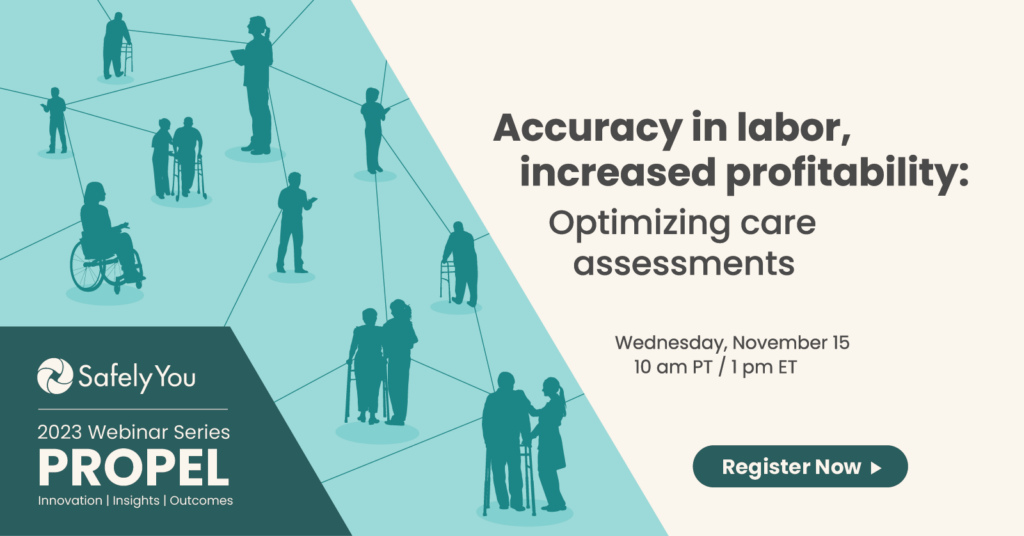Falls are particularly common in senior housing communities, where many of the residents can no longer independently perform activities of daily living. While falls will always be a challenge, communities have a great opportunity to prevent falls by focusing on room design, which plays a large role in the safety and well-being of residents.
Since creating a safe living space necessitates a unique combination of meeting residents’ specialized requirements and analyzing fall metrics, the fall experts at SafelyYou leveraged insights from more than 14,000 fall video reviews to develop a streamlined approach to “Designing a Safe Living Space.” With this approach, senior housing operators and direct-care staff can quickly get up to speed on best practices and implement measures that will create a safer and efficient environment.
Fall Prevention Begins Before Move-In
The direct-care team should meet with a resident’s family before move-in so they can get to know the resident, explain how to design a room for maximum safety and comfort and share examples of an optimal living space. SafelyYou developed two downloadable resources, Three Conversation Tips and a Move-In Checklist, to help the direct-care staff guide these important discussions.
Three Conversation Tips highlights important details to convey to family members so the direct-care team can learn personal habits, routines, likes and dislikes so a resident’s needs can be met immediately. For example, knowing sleeping schedules, food preferences and favorite TV shows will go a long way in keeping a resident content and calm. And, inviting family members to see the room before move-in is the perfect opportunity to share the exact room dimensions and examples of good floor plans to help family members understand optimal furniture size and positioning.
The direct-care team also can use the Move-In Checklist to review mobility status to determine the level of assistance needed for transfers, dressing and showering. You can also learn what personal items they need to use regularly and place them within easy reach. If a mobility aid is used, you can discuss how to create a clear pathway to enter and exit the room with the family.
Optimize the Environment for Rest and Sleep
It is estimated that sleep problems impact 25% of those with mild to moderate dementia and 50% of those with severe dementia. Poor sleep can easily increase agitation and confusion during waking hours and increase the risk of falls. To combat these issues, SafelyYou recommends:
- Assessing bed type: Determine if the bed is the right width and length for a resident. Examine a resident’s ability to get in and out of bed and match their status with the proper bed features. Assess status on a regular basis, because a resident may need to switch from a full-size to a twin bed or need a hospital bed as their dementia progresses.
- Determining bed placement: Establish the best placement for maximum safety. Position bed flush against the wall to provide a clear pathway for entering and exiting the room. The additional space is also needed to perform transfer techniques.
Optimize the Environment for Peace and Familiarity
Residents need a calm and peaceful environment without clutter, which creates visual noise and anxiety. A well-organized space also promotes serenity. Simple things like labeling drawers to improve the ability to locate key items, designating locations for important items, and providing visual stimulation through personal photographs will help residents become familiar with their surroundings and feel more peaceful.
It’s also important to factor in visual considerations and improves the quality of lighting in the living space. A glare is disorienting for residents and shadows can be confusing and disturbing. For instance, a resident may think a stranger is standing in the corner due to a shadow, so you can move furniture that is blocking light.
Optimize the Environment for Navigation and Access
When residents are trying to use their mobility aid in a cluttered environment, they feel like they are navigating a complex maze. And when you factor in that 59% of SafelyYou-detected falls show mobility aids are not used or used improperly, it adds up to a perfect storm for a fall to occur.
The solution is to avoid oversized or unnecessary furniture, remove obstacles from pathways, evaluate how a resident navigates doorways, and limit the use of unstable furniture, such as folding tables. As dementia progresses, it is crucial to periodically assess a resident’s ability to safely use a mobility aid. Update your care plan with the type of mobility aid a resident uses and where they like it placed in the room when they are alone. Also, keep a mobility aid within reach if a resident can self-transfer and out of view if they can’t.
Reassess Residents to Keep Room Design Current
As dementia progresses, residents’ cognitive abilities and mobility status will change, and their room design must keep pace with their declining health. It is imperative to reassess a resident’s condition once a month and modify their environment accordingly. Consider mobility status with room design
- Remove unnecessary furniture and clutter
- Add environmental sweeps to wellness rounds
- Frequently assess the environment and modify as needed
Falls will still happen – although, less frequently. By following SafelyYou’s streamlined approach, communities can make the most of the space they have and access the tools needed to take immediate action and reduce falls.
To learn more, download the whitepaper, Designing a Safe Living Space: Leveraging Room Design as a Market Differentiator To Promote Safety. For more information about reducing falls in your community, contact [email protected].





